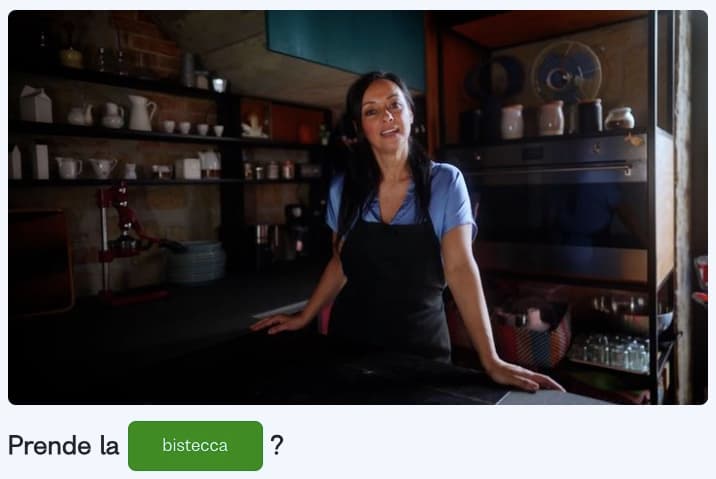I want to learn...
What is an Italian definite article? We use definite article or articoli determinativi to refer to specific people, places, animals or things. In English, we say “the.” It’s our only definite article, but Italian has seven of them! Italian has so many definite articles because they agree with their noun’s gender (masculine or feminine), number (singular or plural), and the first few letters of the noun it’s introducing.
If seven sounds like a lot, don’t worry! Once you see the pattern, it becomes pretty simple to understand. After this article, you’ll know all the ways to say “the” in Italian and how to use them.
Italian definite articles
Here are all seven of the Italian definite articles.
Remember: Italian is a gendered language, so every noun will be either masculine or feminine. You can typically tell whether a word is feminine or masculine depending on its ending: -a usually signifies feminine, while -o signifies masculine. There are always exceptions, so it’s good to learn words along with their
Masculine definite articles in Italian
| Masculine | Singular | Plural |
|---|---|---|
| begins with a consonant | il il libro | i i libri |
| begins with a vowel | l’ l’albero | gli gli alberi |
| begins with s + consonant, i + vowel, gn, pn, ps, x, y or z | lo lo stadio | gli gli stadi |
Feminine definite articles in Italian
| Feminine | Singular | Plural |
|---|---|---|
| begins with a consonant or with i + vowel | la la donna la iena | le le donne le iene |
| begins with a vowel (except i + vowel) | l’ l’amica | le le amiche |
When do we know which Italian definite article to use?
In Italian, we decide what article to use depending on whether the noun:
Is masculine or feminine
Is singular or plural
Starts with a consonant, a vowel (a, e, i, o, u), or certain special consonants/groups of letters (like sp or z).
Singular article:il, lo and l’
There are three masculine singular definite articles: il, lo and l’. Let’s take a closer look at each of these, starting with il.
1. Italian masculine singular definite article:il
Il is for masculine singular nouns starting with a consonant (unless that consonant is an x, y, z, gn, pn, ps, or s + consonant. More on that below).
il ragazzo (the boy)
il vino (the wine)
il gatto (the cat)
2. Italian masculine singular definite article:lo
Lo is used with masculine singular nouns that start with an s + consonant (sp, st, sc, sr, etc.), i + vowel, gn, pn, ps, x, y or z. This is because it improves the sound and fluidity of pronunciation.
lo zio (the uncle)
lo studente (the student)
lo spagnolo (the Spaniard)
lo yogurt (the yogurt)
lo gnomo (the gnome)
lo psicologo (the psychologist)
lo xilofono (the xylophone)
3. Italian masculine singular definite article:l’
Now, l’ can be used with both masculine or feminine singular nouns that start with a vowel (a, e, i, o, u) or the letter h, because the “h” is “muta” (silent) in Italian. Exception : i + vowel that is introduced by 'lo
We mesh the sound with the following noun’s vowel because doing so improves pronunciation. You can actually see this concept applied in English too—for example, it’s easier to say “an apple” than “a apple”. The definite article is bolded in the examples below:
l’ape (the bee)
l’insalata (the salad)
l’amico (the friend)
l’ora (the hour)
l’hotel (the hotel)
l’una (one o’clock)*
Note: It’s important to pronounce the article and the following vowel smoothly, with no pause in between. L’una sounds exactly like “luna” (the moon) when spoken out loud. Italian speakers know which one you are talking about based on the context.
There are two feminine singular definite articles,la and l’. We’ve already covered l’ so let’s look at la.
4. Italian feminine singular definite article:la
La is the definite article for feminine, singular words.
la ragazza (the girl)
la pizza (the pizza)
la sedia (the chair)
la testa (the head)
Plural article: i / le / gli
Now we can get to the definite articles for plural nouns in Italian.
1. Italian definite article for plural nouns:i
Pronounced “ee”, this article is paired with all masculine, plural nouns that begin with regular consonants.
i figli (the children)
* i vini (the wines)i giorni (the days)
2. Italian definite article for plural nouns:le
We use the article le before all female plural nouns, no matter whether they begin with a vowel or not.
le penne (the pens)
le case (the houses)
* le api (the bees)le sedie (the chairs)
le insalate (the salads)
3. Italian definite article for plural nouns:le: gli
Last but not least is gli. This will go before masculine plural nouns that start with a vowel or those special consonants or letter groups that you saw earlier (s + consonants, x, y or z, etc.):
gli orologi (the watches)
gli aerei (the planes)
gli alberi (the trees)
gli studenti (the students)
gli zaini (the backpacks)
gli yogurt (the yogurts)
gli psicologi (the psychologists)
gli gnomi (the gnomes)
Gli is a tricky word for native English speakers. The “g” is almost silent and it’s pronounced like “ly” as in “certainly” in English, but with a very soft “l”. Watch this video for a sample pronunciation.
10 tips for using definite articles in Italian
Generally, Italian speakers use definite articles in the same way as English speakers do—when referring to a person or a thing that was introduced before, that everyone in the conversation knows, or when referring to people or things that are unique (such asil papa, the pope).
But Italian speakers use definite articles more often than English speakers, and there are a few key differences you should know:
Italian speakers use definite articles alongside possessive adjectives unless referring to a close family member.
la mia casa (my house)
le tue sedie (your chairs)
i suoi studenti (her/his students)
i loro biscotti (their biscuits)
2. Unlike English, Italian puts definite articles in front of abstract concepts.
l’amore (love)
la pace (peace)
la bellezza (beauty)
3. Italians always place a definite article before a language, unless they’re using it with a verb like parlare (to speak) when it is OK to omit the article.
L’italiano (Italian)
Lo spagnolo (Spanish)
But if you want to say “I speak Italian,” you’d say “parlo italiano”, with no definite article.
4. Italians use definite articles with sports.
Il calcio (soccer)
Il tennis (tennis)
La pallacanestro (basketball)
5. Italians tell time with definite articles.
Sono le 7:00. (It’s seven o’clock.)
È l’una in punto (It’s exactly one o’clock.)
6. Italians also use it for dates (unless you also say the day of the week) and years.
Domani è il 25 marzo. (Tomorrow is the 25th of March.)
If you say the day of the week, then don’t use the definite article: Domani è mercoledì 25 marzo.
Il prossimo anno è il 2024. (Next year is 2024.)
7. If you’re talking about days of the week or parts of the day in which an activity is usually repeated, use a definite article.
Faccio sempre colazione il sabato mattina. (I always have breakfast on Saturday mornings.)
La sera vado a un corso d’arte. (I go to an art class every evening.)
8. Definite articles are used with titles (but never when speaking to someone directly).
Il Professore Colombo (Professor Colombo)
La signora Russo (Mrs. Russo)
9. Use Italian definite articles for clothes and parts of the body if there’s a reflexive verb before the noun.
In fact, you won’t use the possessive article (mio, tuo,etc.) in this case—only the definite article.
Mi lavo i denti. (I brush my teeth.)
Mi metto la giacca. (I put on my jacket.)
Mi lavo le mani. (I wash my hands.)
Mi intreccio i capelli. (I braid my hair.)
10. Italians will use the define article for most geographic locations.
This includes countries, islands, seas, lakes, mountains, etc., but not for cities / towns.
L’Italia (Italy)
La Sicilia (Sicily)
Il Lago di Como (Lake Como)
Il Monte Vesuvio (Mount Vesuvius)
Il Tevere (The Tiber)
Note: you won’t use the definite article if the and with that, we’re done learning all about definite articles in Italian! Understanding and using Italian definite articles will get easier—because you will see and hear them all the time. With practice, they’ll become like second nature.
At Busuu, we’re committed to life-long learning. We can help you apply these grammar rules in real conversations and practices!
Newlanguages


